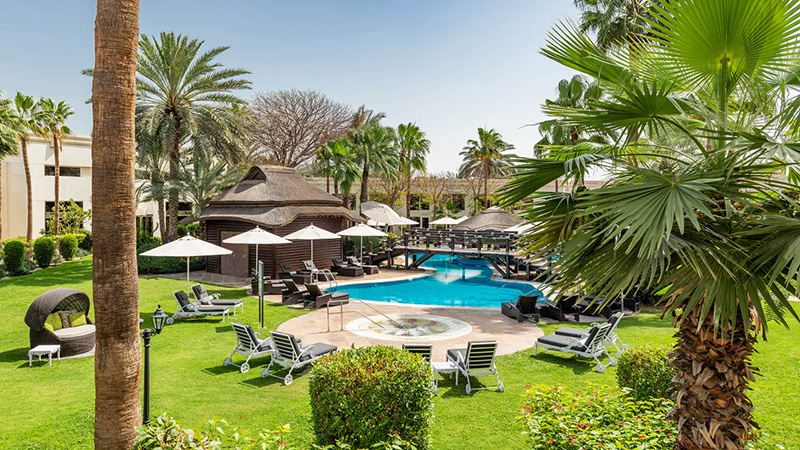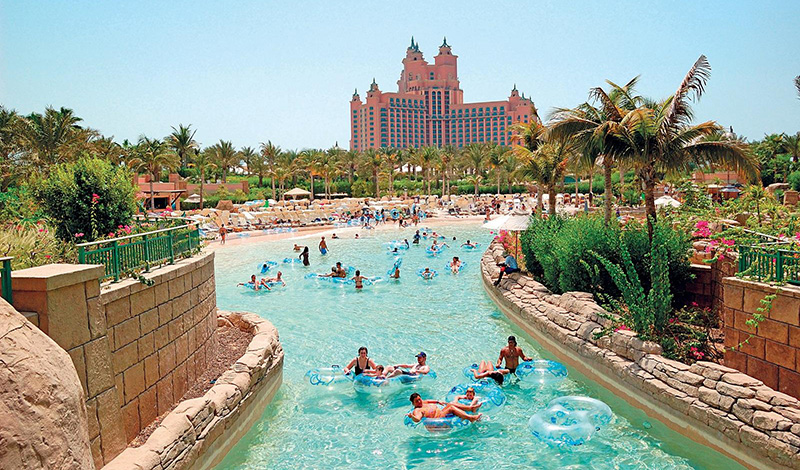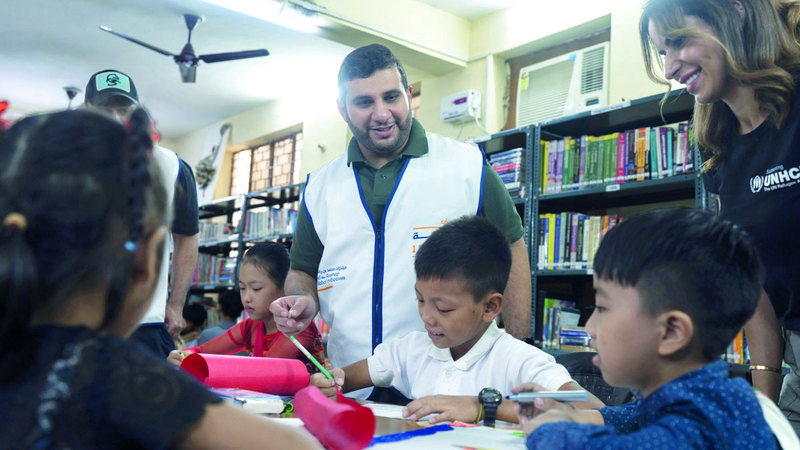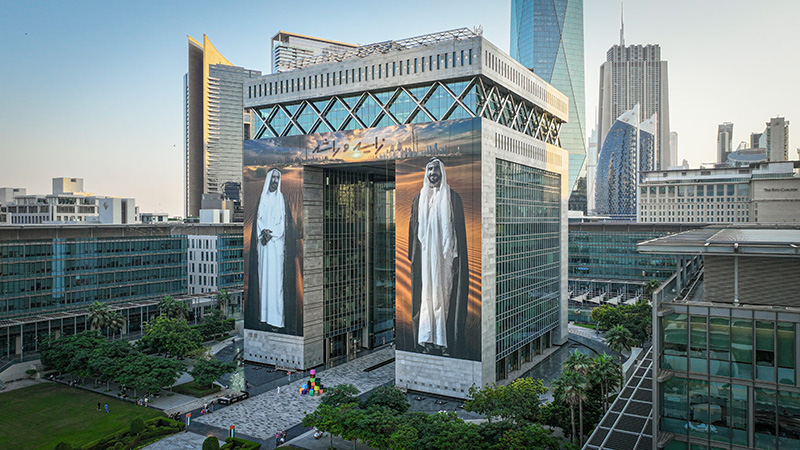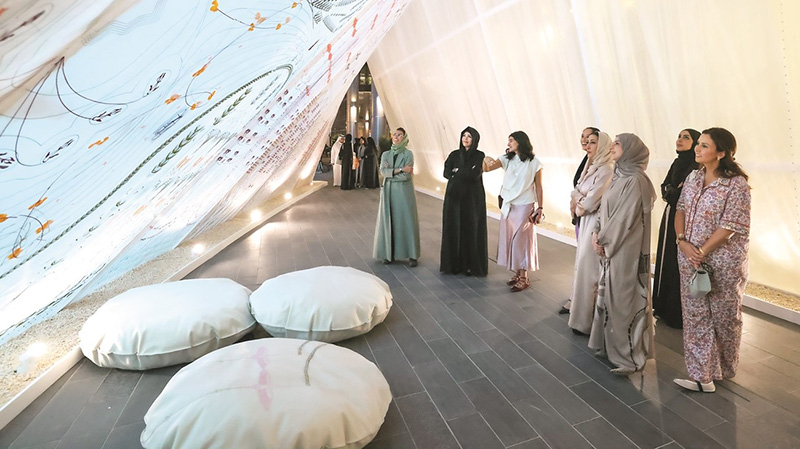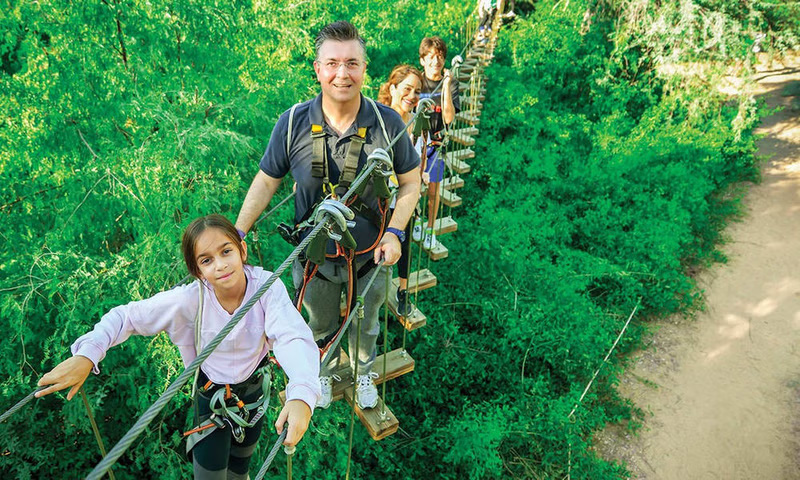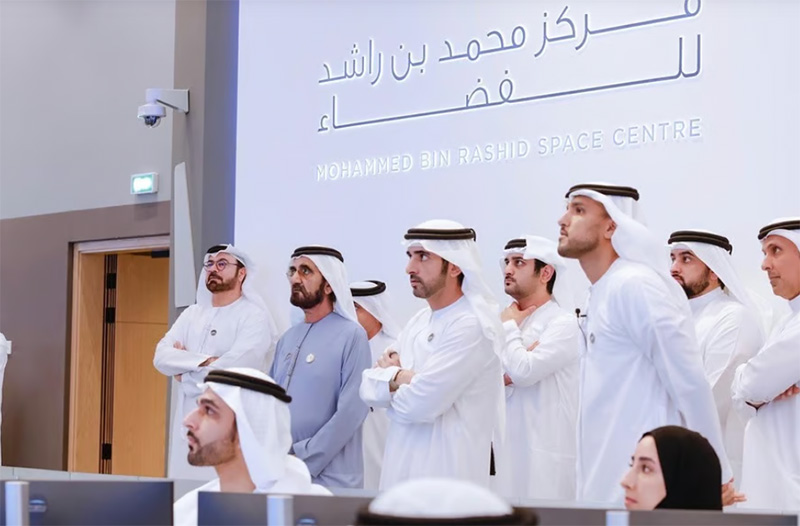
“Reaching Mars is not just a scientific goal, but a message to our future generations that we are capable, and nothing is impossible with hope.”
Mohammed bin Rashid Al Maktoum
Less than a year after these words were spoken, the landmarks of the United Arab Emirates were bathed in red on the evening of February 9, 2021. This celebration marked the arrival of the Hope probe into orbit around the Red Planet, making the UAE the fifth entity in the world, and the first in the region, to operate a scientific spacecraft at Mars, all while the nation was still celebrating the 50th anniversary of its founding. In a journey that transformed Dubai into a knowledge ecosystem complete with specialized space science laboratories in Al Khawaneej (home of the Mohammed bin Rashid Space Centre), satellites are being designed by Emirati hands. This shift from desert sand to orbit is measured not only in flight time but in its capacity to reshape society’s relationship with science. The lab here is more than a technical goal; it is a platform that cements a dream grounded in method and experience, charting an Arab roadmap that begins in Dubai and literally extends beyond Mars.
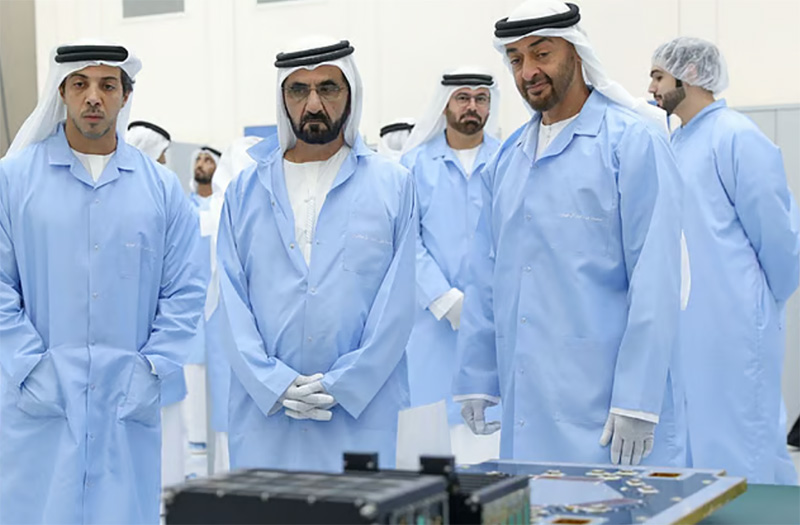
From a NASA Photo to a Space Institution
In 1976, Sheikh Zayed bin Sultan Al Nahyan, the UAE’s President from 1971 to 2004, met three Apollo 17 astronauts at Al-Bahr Palace in Abu Dhabi. The photograph taken that day was dubbed “the meeting through which the Gulf peered into space.” In the photo, Sheikh Zayed is inspecting a model of an American space shuttle, a scene that may have seemed like a mere diplomatic gesture to onlookers at the time, but it contained an early insight: Sheikh Zayed saw the sky as a natural extension of the desert, and space as a tool for knowledge empowerment. At that stage, the UAE had no academic program granting a degree in space engineering; the first domestic specialization in this field would emerge 37 years later, in 2013, via a partnership between Mubadala and the UAE University. This means the dream of space began as a political aspiration long before any national knowledge infrastructure was in place.
Nearly three decades later, Sheikh Mohammed bin Rashid Al Maktoum, Ruler of Dubai, nurtured that symbolic seed into an institutional reality. On February 6, 2006, he decreed the establishment of the Emirates Institution for Advanced Science and Technology (EIAST) to serve as a laboratory for training Emirati engineers in satellite design and giving them hands-on manufacturing experience in Korea and Japan. Less than a decade after that, he merged this institution into a broader entity named the Mohammed bin Rashid Space Centre under Law No. 17 of 2015, explicitly mandating three strategic objectives: building an integrated national infrastructure for satellite manufacturing, leading the first Arab mission to another planet, and producing the human capital needed to move from being merely users of technology to becoming its producers.
DubaiSat-1: From Collaboration to Empowerment
The UAE’s space journey effectively began when DubaiSat-1 lifted off at 18:46 GMT on July 29, 2009, from the Baikonur Cosmodrome. The satellite, weighing 190 kilograms, entered a sun-synchronous polar orbit about 680 kilometers above Earth. It relied on 330 watts of power to operate a DMAC camera capable of capturing 2.5-meter-resolution panchromatic images and 5-meter multispectral images, providing sufficient detail to observe coastal changes and urban expansion far more effectively than any domestic capability at the time. Yet the deeper value lay in knowledge transfer: Emirati engineers comprised nearly 30% of the manufacturing team and spent years working at Satrec Initiative in South Korea, learning spacecraft systems engineering and testing. After launch, they took charge of operating the satellite and its Dubai ground station. In this way, the mission became a national learning laboratory, connecting scientific research to coastal development and government services, and laying the foundation for a locally sourced space data economy.
When DubaiSat-2 reached orbit on November 21, 2013, it marked a dramatic acceleration of capability. The 300-kilogram satellite, deployed into a sun-synchronous orbit at about 600 kilometers altitude, featured the HiRAIS system for one-meter-resolution panchromatic imaging and an instantaneous swath of 17,000 square kilometers per orbit. Its data download rate was five times faster than its predecessor’s. Perhaps most significantly, sixteen Emirati engineers led the mechanical and software design and testing of the satellite, raising the rate of national participation to twice that of the first mission. The Korea-UAE partnership thus evolved from basic training into research collaboration, enabling the local team to develop the first experimental electric propulsion system in the history of Arab satellites.
KhalifaSat: A Fully Emirati Endeavor
On October 29, 2018 (UAE time), a Japanese H-IIA rocket lifted off from Tanegashima Island carrying KhalifaSat. This 330-kilogram Earth observation satellite was placed into a sun-synchronous orbit at an altitude of 613 kilometers, allowing it to circle the globe about 14.5 times per day. More significant than the launch itself was the fact that KhalifaSat was planned, assembled, and tested at the Space Technology Laboratories in Dubai, a facility established in 2014 to support the UAE’s emerging space industry. Equipped with thermal vacuum chambers and large vibration tables, it enabled 100% of the integration work to be completed in the country, whereas DubaiSat-1 and 2 had only progressed to final design stages in South Korea.
The team that began with just eight engineers in training at Satrec Initiative had grown to more than 70 Emirati men and women by the time KhalifaSat was completed, effectively transforming the facility into a sovereign school of space systems engineering. On the technical side, KhalifaSat’s KHCS camera achieved sub-meter resolution, 0.70 m in panchromatic mode and 2.98 m in multi-spectral mode, with 512 gigabits of onboard storage. Its X-band transmitter could downlink data at up to 320 megabits per second, twice the speed of its predecessor, DubaiSat-2.
Under optimal conditions, KhalifaSat was able to beam a captured image to the Dubai ground station in under 20 minutes. In its first year alone, it delivered 7,250 high-resolution images that were used for city planning and monitoring coastal change, and its data was added to the Pangyo Alliance, which provides global daily coverage via 13 satellites. Yet its greatest value came in the form of documented knowledge: KhalifaSat generated five patents, among them an automated target tracking technique that adjusts imaging in real time, and seven other engineering innovations in the camera’s structure and carbon shielding. These achievements cemented the UAE’s transition from a technology consumer to a nation that commands every stage of satellite production from design through launch, and even sells high-resolution space imagery to commercial clients worldwide. In this way, the satellite became more than just a remote-sensing platform; it represented a new social contract, redefining Emirati youth’s relationship with space science and reminding urban planners, environmentalists, and economists that sovereignty in the 21st century is measured by a nation’s ability to harness its own innovation engines, not by the volume of data it imports from others.
From a Ministerial Retreat to Mars
In a late-2013 ministerial retreat on Sir Bani Yas Island, Sheikh Mohammed bin Rashid, Prime Minister of the UAE, handed each government minister a blank page dated December 2, 2021, the UAE’s Golden Jubilee, and asked them to write the headline they wished to see by then. Sheikh Mansour bin Zayed, Deputy Prime Minister, wrote boldly: “The UAE reaches space.” At that time, the dream seemed distant, but it reflected the vision in the minds of the nation’s leadership.
Sheikh Mohammed then tasked Minister of Cabinet Affairs Mohammed Al Gergawi with conducting a feasibility study for the project. Al Gergawi visited the UAE Advanced Technology Centre in Al Khawaneej and, after evaluating the country’s existing capabilities, reported to Sheikh Mohammed that the mission was difficult but achievable at an estimated cost of about $200 million, a figure later confirmed to be one of the lowest budgets in the world for a Mars mission. Based on this, Law No. 17 of 2015 was enacted, restructuring the existing institution into the Mohammed bin Rashid Space Centre and assigning it authority over satellites, planetary exploration, and astronaut programs. The operational core of the center had already been set up as a science initiative under the former EIAST, which made it easy to transfer staff and ongoing programs into the new organization once the law took effect.
The Hope Probe
On July 20, 2020, the Hope probe, at a mass of 1,350 kilograms, lifted off aboard a Japanese H-IIA rocket from the Tanegashima Space Center. It traveled some 493 million kilometers before entering orbit around Mars on February 9, 2021. The probe follows a highly elliptical orbit between 20,000 km and 43,000 km, completing a cycle every 55 hours. This orbit allows it to image the entirety of Mars’s atmosphere roughly every nine hours, a coverage frequency no previous mission had achieved.
In its first year in Martian orbit, the Mohammed bin Rashid Space Centre released 110 gigabytes of open scientific data from the mission, followed by quarterly updates that brought the total archive to more than 4.1 terabytes by the end of 2024. All of this data is freely available to researchers through the Emirates Mars Mission data center. This influx of information has fueled a surge in scientific output: by mid-2025, more than 270 research papers have cited data from the probe, covering topics from comprehensive atmospheric maps and new observations of Martian auroras to unprecedented close-up images of Deimos, Mars’s outer moon.
In this way, the Hope probe has transformed from a national symbol into a planetary research instrument. It fills a critical gap in the timeline of Mars climate observations and provides universities around the world with a unique free data archive. It has cemented the Mohammed bin Rashid Space Centre’s status as a knowledge powerhouse on par with much older space agencies, underscoring that the UAE’s investment in space is an investment in the data and scientific economy, not just a fleeting technological showcase.
Astronaut Program: From Symbolic Visit to Scientific Partnership
Having demonstrated the ability to build satellites and send a probe to Mars, the UAE’s space strategy turned toward human spaceflight. The program’s inception came on September 25, 2019, when a Soyuz MS-15 spacecraft carried astronaut Hazzaa Al Mansouri to the International Space Station (ISS), making him the first Emirati, and the first Arab, to live onboard. During his eight-day stay, he conducted 31 scientific experiments: 16 in collaboration with international space agencies and 15 designed for students in UAE schools, turning what could have been a symbolic visit into a practical, educational endeavor.
This achievement paved the way for a longer mission. On March 2, 2023, astronaut Sultan AlNeyadi launched aboard a SpaceX Crew-6 mission to the ISS, where he spent 186 days, setting the record for the longest spaceflight by an Arab national. AlNeyadi carried out over 200 experiments totaling around 600 hours, ranging from immunology studies to fluid dynamics in microgravity, and the mission culminated with the first Arab spacewalk, lasting 7 hours and 1 minute on April 28, 2023.
At the same time, the UAE Astronaut Programme, launched in 2017 with more than 4,000 applicants, continued to grow. After the missions of Al Mansouri and AlNeyadi, in 2021 the UAE selected its first female Arab astronaut, Noura Al Matrooshi, along with her colleague Mohammed Al Mulla, to begin full training at NASA’s Johnson Space Center under an agreement running through September 2025.
Thus, what began with Al Mansouri occupying a guest seat on the ISS evolved into an integrated scientific partnership led by AlNeyadi, with Emirati astronauts now part of the station’s crew and research agenda. The outcome is that the UAE’s astronaut program has plugged the nation into the ISS’s scientific production network, demonstrating that investing in human capital is no less vital than investing in rockets.
Post-Mars Steps
Since announcing a lunar mission in 2021, the Mohammed bin Rashid Space Centre has advanced steadily from the Moon’s surface toward the asteroid belt, plotting an integrated path that links scientific discovery with the development of local industrial value chains. Rashid-1, a 10-kilogram spacecraft launched aboard the Japanese Hakuto-R mission, provided real-time telemetry on its final approach to the Moon’s rugged surface, despite ultimately failing to land when it crashed on April 25, 2023. The experience was immediately fed into an upgraded design: Rashid-2, equipped with new thermal and mechanical sensors, is scheduled to travel with Intuitive Machines’ Nova-C lander (named Blue Ghost) to the far side of the Moon in 2026, turning the lesson of the previous attempt into a higher-engineered version.
In May 2023, the UAE unveiled its mission to the asteroid belt: the MBR Explorer spacecraft, scheduled for launch in March 2028. It will journey five billion kilometers past three planets and seven asteroids before entering orbit around and landing on asteroid 269 Justitia in 2035, using a series of gravity assists, from Venus, then Earth, then Mars, to reach its target. This mission is not about setting a distance record; rather, it is a test of the Centre’s ability to manage a long-duration, multi-target voyage using the same open-science platform approach as the Hope probe.
The Centre also inaugurated its commercial era with the January 14, 2025 launch of the MBZ-SAT satellite. This 750-kilogram satellite delivers sub-meter-resolution imagery and features an onboard scheduling and processing system that provides images within two hours of capture. Remarkably, 90% of MBZ-SAT’s mechanical components were manufactured by UAE-based companies, turning the satellite development program from a mere line item of technology import into a driver for localizing the advanced space industry.
From the lessons of Rashid-1 to the high-resolution imaging economy of MBZ-SAT and through the voyage of the MBR Explorer, the philosophy of the Mohammed bin Rashid Space Centre emerges clearly: every scientific step is crafted to redistribute surplus knowledge across society and the private sector. In this way, investment in space becomes direct investment in the skills of engineers and in national supply chains, rather than merely an expedition to the fringes of the solar system.
Space Re-engineers Society
The vision of the Mohammed bin Rashid Space Centre goes beyond the confines of laboratories and rockets to reshape the relationship between Gulf society and knowledge itself. When reaching Mars or the asteroid belt becomes part of everyday life, in school curricula, university research projects, and private-sector startups, space becomes a tool for building new behaviors in learning, work, and decision-making. Here, social philosophy intersects with political economy: investing in orbit is not merely a scientific endeavor but a policy that redistributes intellectual capital within the country and creates spheres of influence reaching from the classroom to the high-tech markets.
On this basis, space programs are not seen as isolated engineering adventures but as a civilizational narrative redefining what is possible in a region long characterized as a consumer rather than a producer of technology. From the shores of the Gulf to the orbits of Mars and the asteroid belt, Emiratis are forging both a physical and symbolic path in the sky. They are drawing maps not just for space navigation, but for a future in which a nation’s wealth is measured by its ability to expand the boundaries of knowledge and convert it into sustainable social and economic value.


